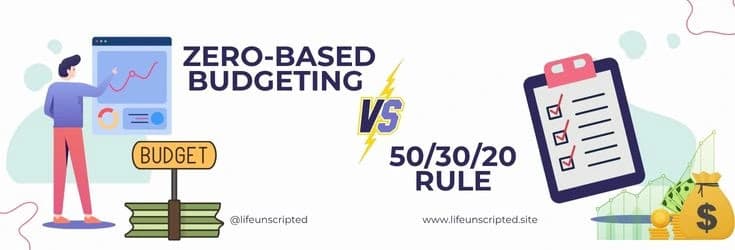Budgeting Methods: Taking Charge of Your Money
Budgeting is an effective way to take charge of your finances. Among the most popular methods are Zero-Based Budgeting and the 50/30/20 Rule. The right choice depends on your money goals, income type, spending habits, and how much time you can spend managing money.
In this article, we'll dive deep into both budgeting styles with examples, pros and cons, real-life situations, and help you pick what fits your life today.
What is Zero-Based Budgeting?
Zero-Based Budgeting (ZBB) means giving every dollar you earn a job. At month's end, income minus expenses equals zero. This doesn't mean spending everything - it means telling every dollar where to go: savings, rent, bills, or other needs.
How it Works:
- Calculate your monthly income
- List all expected expenses: bills, food, savings, debt, etc.
- Assign money to each category until every dollar is placed
- If income minus expenses isn't zero, adjust
Simple Example ($3,000 income):
- Rent: $1,000
- Groceries: $400
- Utilities: $200
- Debt payments: $300
- Savings: $500
- Transportation: $200
- Entertainment: $200
- Others: $200
Total = $3,000 (Income - Expenses = 0)
What is the 50/30/20 Rule?
A simpler method that splits income into three categories:
- 50% for Needs: Rent, food, utilities, health, minimum debt
- 30% for Wants: Dining out, entertainment, shopping, travel
- 20% for Savings & Debt: Emergency fund, retirement, extra loan payments
How it Works:
Take your after-tax income and divide:
Example ($3,000 income):
- Needs (50%): $1,500
- Wants (30%): $900
- Savings/Debt (20%): $600
This method gives flexibility without tracking every dollar.
Budgeting Methods Comparison
| Feature | Zero-Based Budgeting | 50/30/20 Rule |
|---|---|---|
| Detail level | Very detailed | Broad categories |
| Time needed | High | Low |
| Best for | Variable income, detailed control | Beginners, stable income |
| Flexibility | Custom to your life | Fixed ratios |
| Savings priority | You decide amount | 20% suggested |
Pros and Cons
Zero-Based Budgeting
Pros:
- Every dollar is planned
- Great for getting out of debt
- Finds waste in spending
- Makes you think about money choices
Cons:
- Takes more time
- Can feel strict
- Needs regular tracking
50/30/20 Rule
Pros:
- Simple to remember
- Good for beginners
- Less daily work
Cons:
- Too general for some
- May not work in expensive cities
- Not ideal for early retirement goals
Which Method Works Best Now?
In a High-Inflation Economy (2025)
Zero-Based Budgeting wins. When prices jump fast, you can move money between categories. The 50/30/20 rule isn't flexible enough for quick changes.
If You're in Debt
Zero-Based Budgeting is better. You can put extra money toward debt without being limited by the 20% cap in 50/30/20.
If You're Busy or New to Budgeting
50/30/20 Rule is easier. Quick to set up and needs fewer changes. Good for building money habits.
For Freelancers or Irregular Income
Zero-Based Budgeting works best. Plan month-by-month based on what you actually earn.
Which Budget is Good for a Developing Economy?
Zero-Based Budgeting (ZBB) works better than 50/30/20 for countries:
Why ZBB is better:
- Fresh Start Each Year: Requires justifying every expense, stopping automatic funding of old projects
- Focus on Needs: Puts money toward top priorities like clean water, schools, and roads
- Finds Waste: Questions every cost to find poor spending
- Flexible: Adjusts quickly as needs change in growing economies
Why 50/30/20 doesn't fit:
- Too Rigid: Fixed percentages work for people but not countries
- Ignores Big Needs: Developing nations need to spend >50% on basics like hospitals
- "Wants" Don't Apply: Government spending should focus on development
- Savings Limits Growth: Heavy investment now beats strict savings rules
Real-Life Case Studies
John, the Freelancer
Income: $2,500-$4,500/month. Uses Zero-Based Budgeting to create new plans monthly. Saves more in good months, cuts back in slow months.
Sarah, Full-Time Employee
Income: $3,500/month. Uses 50/30/20 Rule. Balances student loans with travel without tracking every dollar.
Maya, Paying Off Debt
Had $10,000 credit card debt. Used Zero-Based Budgeting to throw extra money at debt. Paid off 70% in 8 months.
Hybrid Approach: Best of Both Worlds
You can mix methods:
- Start with 50/30/20 to build awareness
- Switch to Zero-Based for big goals like debt payoff
- Do detailed budgeting 3-6 months/year, then loosen up
- Use Zero-Based only for savings/debt categories
Tips to Make Any Budget Work
- Be honest about your spending before choosing a method
- Use apps like YNAB (ZBB) or Mint (50/30/20)
- Review monthly and adjust for price changes
- Automate savings and bills
- Set clear money goals
Conclusion
So, which budgeting method wins?
Use Zero-Based Budgeting if: You want control, have changing income, or have big goals like debt payoff or saving for a house.
Use the 50/30/20 Rule if: You want something easy, have steady income, or are new to budgeting.
Both help you manage money better. Choose what fits your life today - you can always switch later.
FAQs
Is Zero-Based Budgeting better for low income?
Yes. ZBB forces you to plan every dollar, which is crucial when money is tight.
Can I use 50/30/20 in high-cost areas?
You may need to adjust the percentages (e.g., 60/20/20) to match reality.
How often should I update my budget?
ZBB: Monthly. 50/30/20: Every 3-6 months or after major income changes.
What apps support these methods?
ZBB: YNAB, EveryDollar. 50/30/20: Mint, Monarch.
Can I use both methods?
Yes! Many start with 50/30/20 then move to ZBB, or use ZBB just for savings/debt.

